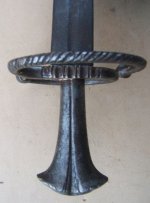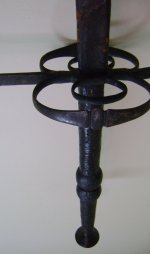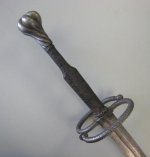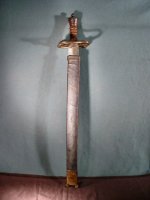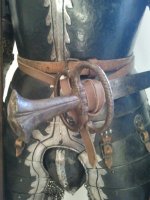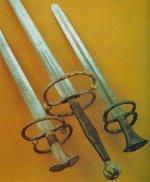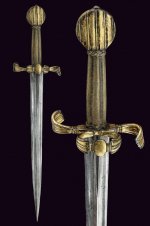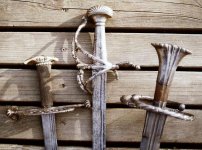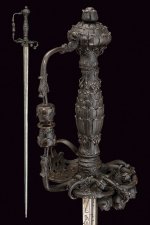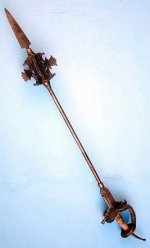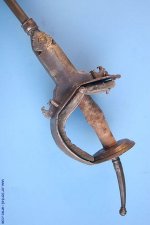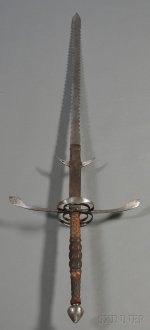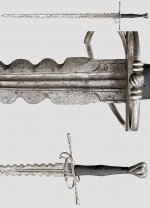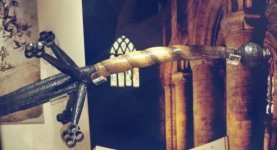This article is somewhat of a build up on the 17th century Electric Swords one. Flame-bladed swords are also known as flambard, flammard, flammenschwert and flamberge.
- These swords have a very distinctive look. I'm pretty sure you have seen those at one point or another.
Flamberge

The official description for these weapon is as follows: The flamberge is an undulating blade that is found on both long blades and rapiers. When parrying with such a sword, unpleasant vibrations may be transmitted into the attacker's blade. These vibrations cause the blades to slow contact with each other because additional friction is encountered with each wave. The term flamberge was misapplied to refer to two-handed swords and was used later to refer to cup hilt rapiers with a straight blade.
The two-handed flame-bladed sword is called flambard, flammard or by the German Flammenschwert (literally "flame sword"). These swords are very similar to two-handed sword or Zweihänder, the only difference being the blade. Like other Zweihänders they were used during the 16th century by the Landsknechts, well-trained and experienced swordsmen, who were called Doppelsöldner (double mercenary) because they received double pay.
- And who were those Landsknechts? The German Landsknechts, sometimes also rendered as Landsknechte, were colourful mercenary soldiers with a formidable reputation, who became an important military force through late 15th- and 16th-century Europe. Consisting predominantly of German mercenary pikemen and supporting foot soldiers, they achieved the reputation for being the universal mercenaries of early modern Europe.
Interesting, but I was unable to find any woodcuts of Landsknechts with an actual Flamberge Sword. On the 1872 image below we have:
- 1 through 8: German and Italian sword and rapiers
- 9 and 10: German and Italian daggers
- 11 and 12: Swiss flamberge
- 13 and 14: Moorish weapons of Boabdil
Could those cross-guards be some sort of Tesla coils?
Below are images of some additional swords I was able to Google out of the internet. Those are some interesting hilt designs, in addition to a few straight up bizarre weapons.
It seems Attila the Hun could have had a very similar sword. And we all remember what a story is associated with his special sword. Sword of Mars was the name. It is claimed to be kept in a Vienna museum, but a few believe it is really the sword of Attila.
Additionally we have these "Lantern Shields" and "Russian Tarch Shields". They also have the design that could be a suspect.
While I was unable to find any engravings with flamberge swords being used by Landsknechts, the description of these Landsknechts sounds like they were some 15th century Special Forces. Then again, may be there is a reason why I was unable to find any 15th-16th century engravings of the flamberge swords. We have a single image coming from the 17th century Electric Swords article.
I was fortunate enough to find an X-ray image of various hand grips utilized in "Bronze Age" swords. And here is what they look like.
- Unfortunately, I have not seen any X-rays pertaining to 14th - 16th centuries.
- IMHO, bronze age limitation on these grips is not really relevant, due to our chronology being all screwed up.
- Digital X-ray examination of swords from the early Bronze Age
Battle of Anghiari
Wikipedia wisdom, "The Battle of Anghiari was fought on 29 June 1440, between the forces of Milan and those of the Italian League led by the Republic of Florence in the course of the Wars in Lombardy. The battle was a victory for the Florentines, securing Florentine domination of central Italy."Check this out, "The battle is well known for its depiction in a now-lost painting by Leonardo da Vinci". There we go again. It is probably painted on the wall of the same room where NASA's lost Moon Landing Footage is being kept. Though "specialists" say that it might be hidden beneath later frescoes in the Hall of Five Hundred.
The painting below is Peter Paul Rubens's copy of Leonardo da Vinci's The Battle of Anghiari.
And here is the fun part of this article. Could this battle be a pro-sport our ancestors enjoyed 500 years ago. How about a hypothetical Continental Light Saber League?
Game Score Board
Continental Light Saber League
Mediterranean Conference
Game date: 29 June 1440
Continental Light Saber League
Mediterranean Conference
Game date: 29 June 1440
The League's Army - 1 : 0 - Florentine Contingent

- The League's Army: ~ 4,000 men
- Florentine Contingent: ~ 4,300 men (plus some additional reinforcements)
- Game (battle) Duration: 4 hours and additionally continued into the night
- Game deciding moment: The Milanese advanced but their right flank was soon ferociously engaged by the Papal troops
- Game (battle) casualties: ONE person - fell off the horse and got trampled.
Summary question: for over four hours 8,000+ warriors were hacking away with theirs swords and other weapons, and the only casualty of this war died because he forgot that "safety comes first"? Go ahead, explain this battle. If this is not bizarre, I don't know what is.
And on top of it, the original Leonardo painting is represented by a copy made by Rubens? Rubens was born 140 years after the battle. Leonardo was also born a bit after the battle, in 1452 but somehow Leonardo da Vinci sounds more credible. It sounds like there was something on Leonardo's painting we were not supposed to see. - detailed Wiki-info: The Battle of Anghiari (painting)


